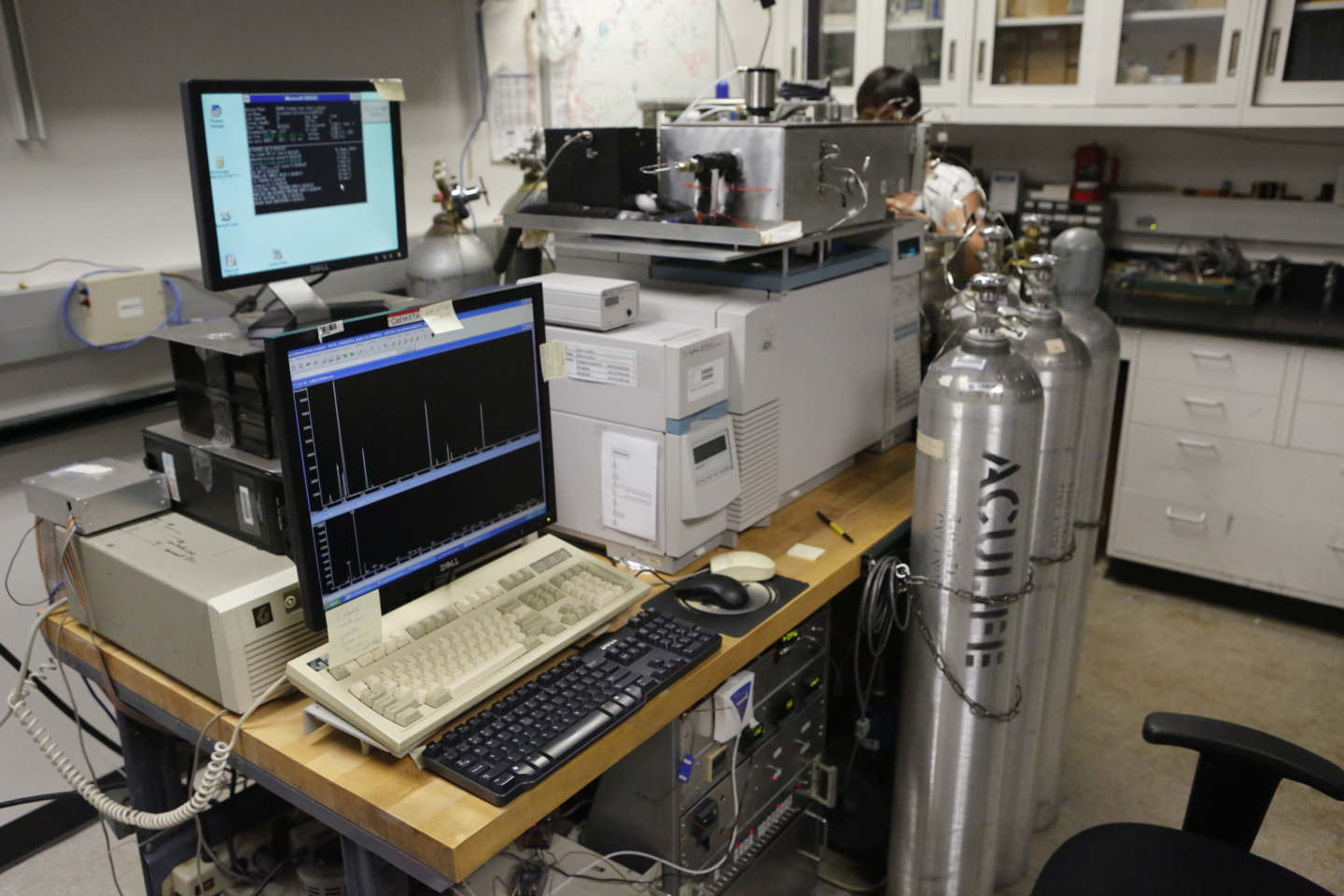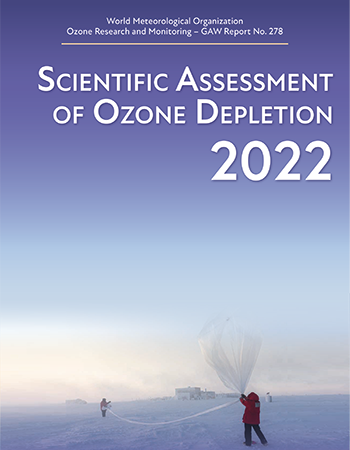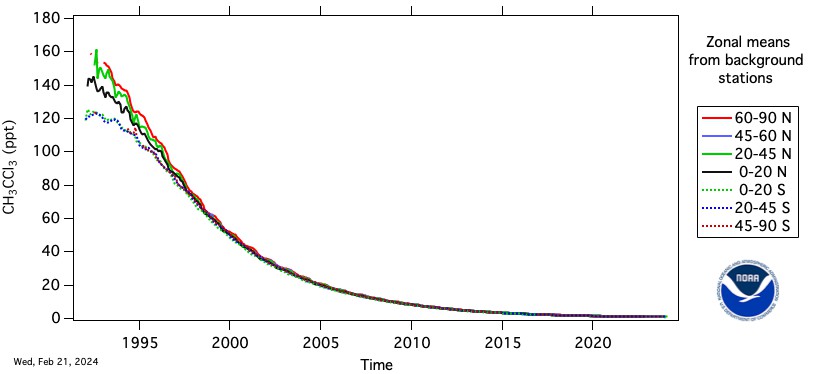C A M P - The Chlorofluorocarbon Alternatives Monitoring Project
In the early 1990's, the Global Monitoring Division of NOAA’s Earth System Research Laboratory (formerly the Climate Monitoring and Diagnostics Laboratory and now the Global Monitoring Laboratory) expanded the HATS flask sampling program to monitor atmospheric levels of chemicals used as substitutes for ozone-depleting gases being phased out by the 1987 Montreal Protocol on Substances that Deplete the Ozone Layer. This research effort, made possible in part by funds from the NOAA Climate Program Office’s AC4 program (formerly known as its Atmospheric Chemistry Project), is focused on making long-term, global-scale measurements of these chemicals and other long-lived gases in order to enable an understanding of how they influence stratospheric ozone, climate, and air quality (see the list of measured chemicals below). A primary goal of the project is to provide, through atmospheric measurements, an understanding of how policy decisions on national to international scales, natural processes, and human activities are altering the atmospheric environment in which we live.

Two primary classes of compounds encompassed by this Project include:
These chemicals represent the first- and second-generation substitutes for the most potent ozone-depleting substances. HCFCs were considered as suitable replacements, at as first-generation substitutes on a temporary basis, owing to their reduced potential to deplete stratospheric ozone. HCFCs have ozone-depletion potentials (ODPs) that are only a fraction (<15%) as large as the ODPs of CFCs. It seems that both the ready availability of HCFCs along with the development of additional alternative processes and chemicals allowed for a timely elimination of CFCs, methyl chloroform, and carbon tetrachloride in the 1990s and early 2000s.
There was concern about long term use of these alternatives, however, as HCFCs contain chlorine and this chlorine contributes to stratospheric ozone depletion. Furthermore, HCFCs are greenhouse gases. Because of this, Amendments to the Montreal Protocol include a schedule for the phase-out of HCFC production for dispersive uses. This phase-out is currently well underway. Countries operating under Article V of the Protocol (also called developing countries) capped their production of HCFCs for the first time in 2013 at levels based on their average baseline production during 2009 to 2010; in 2015 this production allotment is reduced by 10%. Production in non-Article V Parties (developed countries) has been decreasing since 2000 in accordance with the Protocol phase-out, and was scheduled to be no more than 10% of baseline magnitudes in 2015.
The non-ozone-depleting HFCs are first- and second-generation substitutes. HFC-134a replaced CFC-12 in mobile air conditioning and blends of other HFCs (e.g., HFC-125 and HFC-32) have replaced HCFCs in multiple applications. A concern associated use of long-lived HFCs arises because these chemicals are potent greenhouse gases; continued use of these gases, particularly in new emerging markets, would result in significant contribution to climate change through increased radiative forcing. HFC emissions are controlled by the Kyoto Protocol of the United Nations Framework Convention on Climate Change, but this Protocol does not prevent substantial increases in future HFC emissions. It is primarily because of concern about climate change that many Parties to the Montreal Protocol are considering an Amendment to the Montreal Protocol that would limit HFC production. The contribution of HCFCs and HFCs to radiative forcing is regularly updated and included in NOAA’s Annual Greenhouse Gas Index. Finally, a number of the HFCs, for example HFC-134a, decompose in the atmosphere and produce a long-lived chemical called trifluoroacetic acid (or TFA) that is known to have adverse effects on certain biota. In the near future the accumulation of TFA from HFC degradation is expected to be small relative to background levels in most ecosystems.
The Chlorofluorocarbon Alternatives Monitoring Project allows measurements of the global atmospheric distribution of HCFCs, HFCs, and a number of other compounds over time. Samples are currently collected throughout the entire year at continental and remote locations across the globe as part of the HATS flask sampling program. These flasks are analyzed with customized state-of-the-art instrumentation in our Boulder Laboratory. This instrumentation allows for separation and detection of components in air samples with gas chromatography and mass spectrometry techniques (GC-MS). By analyzing 0.2 L of air at a  time, the abundance of these compounds is determined in air at levels as low as 1 part per 10,000,000,000,000 (0.1 part per trillion). Accurate results are obtained by comparing responses from samples to calibration gas standards prepared in the standards lab of the HATS group. The data acquired has provided a wealth of information regarding atmospheric processes, the global societal transition away from use of ozone-depleting substances, and the year to year variability of natural processes affecting the atmospheric environment.
time, the abundance of these compounds is determined in air at levels as low as 1 part per 10,000,000,000,000 (0.1 part per trillion). Accurate results are obtained by comparing responses from samples to calibration gas standards prepared in the standards lab of the HATS group. The data acquired has provided a wealth of information regarding atmospheric processes, the global societal transition away from use of ozone-depleting substances, and the year to year variability of natural processes affecting the atmospheric environment.
Furthermore, along with measurements of alternatives to ozone-depleting substances, GC-MS analysis of flasks in this program has provided a wealth of unique data for other important trace gases on global and regional scales (see Highlighted findings section below). Data for CFCs and other ozone-depleting substances from flask analysis by GC-MS provide a second, quasi-independent measure of atmospheric changes for a subset of gases (CFCs, some HCFCs, and methyl halides) that are also measured by our in-situ gas chromatographs (CATS). Although flasks provide measurements with a much lower sampling frequency than on-site instrumentation, they are collected at more sites and the GC/MS instrumentation provides measurements of a larger number of chemicals. As of 2015, HATS flasks were collected at 16 stations across the globe (see Table 1 in the flask program description).
The flask sampling program also enables measurements of global distributions and trends for methyl halides, chlorinated gases with shorter lifetimes, a number of hydrocarbons including benzene, COS, and additional brominated gases such as CH2Br2 and CHBr3. Some of these gases play important roles in regulating stratospheric ozone; our flask measurements provide a wealth of unique information regarding chemical and transport processes on broad scales. This type of information will enhance our predictive capacity for understanding how these trace gases affect the chemical and radiative state of the atmosphere and its change over time.
National-scale measurements in the HATS group: A collaboration with the Carbon Cycle Greenhouse Gas Group.
In 2004, a program was initiated to allow samples regularly collected from aircraft profiles and tall towers as part of the CCGG participation in the North American Carbon Program to be regularly analyzed in the HATS group. Initially, samples were analyzed on the CAMP GC/MS, but by 2007 additional funding had enabled the construction of second instrument dedicated to analyzing flasks collected by these programs. Thousands of flask samples collected as part of this program, primarily daily flasks collected at approximately 10 tower sites across the U.S., are analyzed each year. The high-frequency and high-density data from this network is unprecedented and provides unique insights into terrestrial (and national) emissions and uptake of the full suite of gases being measured by GC/MS. In 2014 a new instrument (Perseus 1) was constructed to also contribute to the analysis of flask samples collected in these programs.
Highlights of the CAMP program (as of June 2015):
Data collected as part of the CAMP have yielded many insights into the workings of the atmosphere and the role of international policy on the chemical state of the atmosphere. Some highlights:
- Results from three different ongoing measurement programs within the HATS group (CATS, CAMP, and flask analysis also by GC/ECD) were able to observe that total tropospheric chlorine from long-lived gases has been declining since the mid-1990s and total tropospheric bromine in long-lived gases has been decreasing since 1998. These declines are the result of global restrictions on production in the Montreal Protocol and, if they continue, are expected to ultimately lead to the recovery of stratospheric ozone depletion. The progress of the decline in ozone-depleting halogen is tracked by the Ozone-Depleting Gas Index, which is updated annually.

- From a series of papers published starting in 1992, results from the CAMP have provided an early and ongoing measure of global atmospheric concentrations of the most abundant HCFCs and HFCs. These results have been useful for quantifying the contribution of these gases to ozone depletion and climate change (radiative forcing), and for providing independent confirmation of production magnitudes for ozone-depleting substances reported to the Ozone Secretariat to the United Nations Environment Programme and emissions of non-CO2-greenhouse gases reported to the United Nations Framework Convention on Climate Change. Because the atmospheric records span from the early 1990s to today (2015) and are derived from globally distributed measurements, they confirm the adoption of HCFCs and HFCs as substitutes for the most potent ozone-depleting gases first in developed countries and subsequently in developing countries. Accelerated atmospheric increases were initially observed for the HCFCs and are now being observed for the HFCs. The most recent data suggest that the phase-out of HCFCs is beginning to take hold. The data also have been essential for assessing projections of rapid future growth in HFCs.
- CAMP measurements of methyl chloroform and other trace gases have been central to multiple studies that have improved our understanding of an important atmospheric oxidant whose global abundance is difficult to discern but which sets timescales for removal and determines the environmental impact of methane, HCFCs, HFCs, hydrocarbons, and most other chemically-reduced gases. This oxidant, the hydroxyl radical (OH), is also central to lower atmospheric chemistry and the production of tropospheric ozone.
- GC/MS measurements of air in flasks collected as part of the North American Carbon Program (in collaboration with the Carbon Cycle Greenhouse Gas Group) have led to an unprecedented characterization of trace gas concentrations across the U.S. throughout the lower troposphere (up to 8km above sea level). This data is being used to provide national-scale emissions that are independent of inventory-based estimates provided by other U.S. government agencies (e.g., the U.S. Environmental Protection Agency) for the many gases that are measured. Initial data analysis has focused on deriving U.S. emissions (or uptake) of HCFCs, carbonyl sulfide, and carbon tetrachloride.
- Measurements of carbonyl sulfide (COS) in the CAMP program from the HATS global network and from the CCGG tower and aircraft networks suggest that the main flux affecting its global distribution, seasonal variation, and vertical gradient is terrestrial photosynthesis. The work demonstrated a potential for COS to provide a unique view of carbon fluxes that wasn’t previously possible. This potential is being explored by many investigators across the globe. New instrumentation that allows high-frequency measurements of COS has recently been developed by industry and is allowing for new studies of COS fluxes in many different environments.
- Flask measurements by GCMS have been an important part of a number of special projects through the years. Trace-gas histories for periods before regular sampling and analysis was begun have been extracted from air trapped in snow about glaciers (called “firn air”; some HATS firn air data). These studies confirm the purely anthropogenic origin of the ozone-depleting CFCs, HCFCs, methyl chloroform and halons. HATS GC-MS flask instrumentation has been used to improve our understanding of the role the ocean plays in regulating atmospheric mixing ratios of some trace gases, in particular methyl bromide. Results from the analysis of flasks sampled onboard ships in different oceans of the world confirm the conclusions obtained from our ship-board instrumentation and allow insights into the atmosphere-ocean fluxes of a number of other trace gases. Flasks collected during the 5-deployment Pole-to-Pole sampling program HIPPO were analyzed on HATS GC-MS instrumentation. These samples provide a unique snapshot of full tropospheric distributions of trace gases that is highly complementary to the ongoing results provided by the HATS and CCGG sampling programs. GCMS measurements from special projects related to oil and gas development have also provided important insights into the attribution of emissions, particularly methane, being detected in these studies.

- Data from the HATS GC-MS flask sampling program is regularly highlighted as an important independent measure of global atmospheric mixing ratios in WMO Scientific Assessments of Ozone Depletion and in IPCC Working Group I reports on climate change.

HCFCs:
HFCs:
CFCs:
Halons:
Methyl Halides:
Chlorinated Hydrocarbons:
- methyl chloroform (CH3CCl3)
- carbon tetrachloride (CCl4)
- dichloromethane (CH2Cl2)
- chloroform (CHCl3)
- tetrachloroethylene (C2Cl4)
Other chemicals:
- Bromoform (CHBr3)
- Dibromomethane (CH2Br3)
- Benzene (C6H6)
- Acetylene (C2H2)
- Propane (C3H8)
- Carbonyl Sulfide (COS)
Links to measurement data and post-script figures from GML made by CAMP and other programs at GML:
HCFCs
HFCs
CFCs
Chlorinated Solvents
Halons
(The Chlorofluorocarbon Alternatives Monitoring Project is part of the Flask Sampling Program of the Halocarbons and other Atmospheric Trace Species Group (HATS) of GML)
Project Leader: Dr. Stephen A.
Montzka; phone: (303)-497-6657.
Updated June 2015

